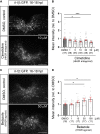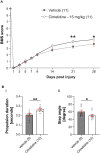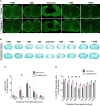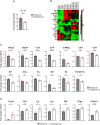Drug screening in zebrafish larvae reveals inflammation-related modulators of secondary damage after spinal cord injury in mice
- PMID: 37215570
- PMCID: PMC10196818
- DOI: 10.7150/thno.81332
Drug screening in zebrafish larvae reveals inflammation-related modulators of secondary damage after spinal cord injury in mice
Abstract
Prolonged inflammation after spinal cord injury is detrimental to recovery. To find pharmacological modulators of the inflammation response, we designed a rapid drug screening paradigm in larval zebrafish followed by testing of hit compounds in a mouse spinal cord injury model. Methods: We used reduced il-1β linked green fluorescent protein (GFP) reporter gene expression as a read-out for reduced inflammation in a screen of 1081 compounds in larval zebrafish. Hit drugs were tested in a moderate contusion model in mice for cytokine regulation, and improved tissue preservation and locomotor recovery. Results: Three compounds robustly reduced il-1β expression in zebrafish. Cimetidine, an over-the-counter H2 receptor antagonist, also reduced the number of pro-inflammatory neutrophils and rescued recovery after injury in a zebrafish mutant with prolonged inflammation. Cimetidine action on il-1β expression levels was abolished by somatic mutation of H2 receptor hrh2b, suggesting specific action. In mice, systemic treatment with Cimetidine led to significantly improved recovery of locomotor behavior as compared to controls, accompanied by decreased neuronal tissue loss and a shift towards a pro-regenerative profile of cytokine gene expression. Conclusion: Our screen revealed H2 receptor signaling as a promising target for future therapeutic interventions in spinal cord injury. This work highlights the usefulness of the zebrafish model for rapid screening of drug libraries to identify therapeutics to treat mammalian spinal cord injury.
Keywords: Betazole, Bortezomib, Sildenafil, Cimetidine; chronic inflammation; histamine receptors; irf8; zebrafish.
© The author(s).
Conflict of interest statement
Competing Interests: The authors have declared that no competing interest exists.
Figures









Similar articles
-
Interleukin-33 treatment reduces secondary injury and improves functional recovery after contusion spinal cord injury.Brain Behav Immun. 2015 Feb;44:68-81. doi: 10.1016/j.bbi.2014.08.002. Epub 2014 Aug 18. Brain Behav Immun. 2015. PMID: 25153903
-
Dynamic control of proinflammatory cytokines Il-1β and Tnf-α by macrophages in zebrafish spinal cord regeneration.Nat Commun. 2018 Nov 7;9(1):4670. doi: 10.1038/s41467-018-07036-w. Nat Commun. 2018. PMID: 30405119 Free PMC article.
-
A Small Organic Compound Mimicking the L1 Cell Adhesion Molecule Promotes Functional Recovery after Spinal Cord Injury in Zebrafish.Mol Neurobiol. 2018 Jan;55(1):859-878. doi: 10.1007/s12035-016-0254-z. Epub 2017 Jan 9. Mol Neurobiol. 2018. PMID: 28070857
-
Know How to Regrow-Axon Regeneration in the Zebrafish Spinal Cord.Cells. 2021 Jun 6;10(6):1404. doi: 10.3390/cells10061404. Cells. 2021. PMID: 34204045 Free PMC article. Review.
-
Unique advantages of zebrafish larvae as a model for spinal cord regeneration.Front Mol Neurosci. 2022 Sep 7;15:983336. doi: 10.3389/fnmol.2022.983336. eCollection 2022. Front Mol Neurosci. 2022. PMID: 36157068 Free PMC article. Review.
Cited by
-
Ursolic acid derivative UA312 ameliorates ionizing radiation-induced cardiotoxicity and neurodevelopmental toxicity in zebrafish via targeting chrna3 and grik5.Acta Pharmacol Sin. 2025 Apr 28. doi: 10.1038/s41401-025-01564-0. Online ahead of print. Acta Pharmacol Sin. 2025. PMID: 40295836
-
Galectin-3 inhibition reduces fibrotic scarring and promotes functional recovery after spinal cord injury in mice.Cell Biosci. 2024 Oct 15;14(1):128. doi: 10.1186/s13578-024-01310-9. Cell Biosci. 2024. PMID: 39407295 Free PMC article.
-
The Promising Role of a Zebrafish Model Employed in Neural Regeneration Following a Spinal Cord Injury.Int J Mol Sci. 2023 Sep 11;24(18):13938. doi: 10.3390/ijms241813938. Int J Mol Sci. 2023. PMID: 37762240 Free PMC article. Review.
-
Deep phenotypic profiling of neuroactive drugs in larval zebrafish.Nat Commun. 2024 Nov 17;15(1):9955. doi: 10.1038/s41467-024-54375-y. Nat Commun. 2024. PMID: 39551797 Free PMC article.
-
Gastrodin promotes CNS myelinogenesis and alleviates demyelinating injury by activating the PI3K/AKT/mTOR signaling.Acta Pharmacol Sin. 2025 Jun;46(6):1610-1623. doi: 10.1038/s41401-025-01492-z. Epub 2025 Feb 26. Acta Pharmacol Sin. 2025. PMID: 40011630 Free PMC article.
References
-
- Dumont RJ, Okonkwo DO, Verma S, Hurlbert RJ, Boulos PT, Ellegala DB. et al. Acute spinal cord injury, part I: pathophysiologic mechanisms. Clin Neuropharmacol. 2001;24:254–64. - PubMed
-
- McDonald JW, Sadowsky C. Spinal-cord injury. Lancet. 2002;359:417–25. - PubMed
-
- Sekhon LH, Fehlings MG. Epidemiology, demographics, and pathophysiology of acute spinal cord injury. Spine (Phila Pa 1976) 2001;26:S2–12. - PubMed
-
- Greenhalgh AD, David S, Bennett FC. Immune cell regulation of glia during CNS injury and disease. Nat Rev Neurosci. 2020;21:139–52. - PubMed
-
- Chio JCT, Xu KJ, Popovich P, David S, Fehlings MG. Neuroimmunological therapies for treating spinal cord injury: Evidence and future perspectives. Exp Neurol. 2021;341:113704. - PubMed
Publication types
MeSH terms
Substances
Grants and funding
LinkOut - more resources
Full Text Sources
Medical
Molecular Biology Databases

